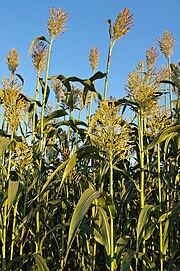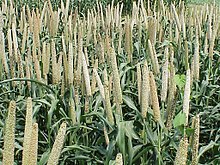showing the food & wine I encountered and their outlets online n offline https://www.facebook.com/lz.folove
Thursday, November 9, 2017
Friday, October 6, 2017
高粱 Sorghum
In China, sorghum is known as gaoliang (高粱), and is fermented and distilled to produce one form of clear spirits known as baijiu 白酒 of which the most famous is Moutai (or Maotai). Sorghum was ground and the flour was the main alternative to wheat in northern China for a long time.
In India, where it is commonly called jwaarie, jowar, jola, or jondhalaa, sorghum is one of the staple sources of nutrition. An Indian bread called Bhakri, jowar roti or jolada rotti, is prepared from this grain. In some countries, sweet sorghum stalks are used for producing biofuel by squeezing the juice and then fermenting it into ethanol.[12] Texas A&M University in the United States is currently running trials to find the best varieties for ethanol production from sorghum leaves and stalks in the USA.[13]
In Korea, it is cooked with rice, or its flour is used to make cake called susu bukkumi.
In Australia, South America, and the United States, sorghum grain is used primarily for livestock feed and in a growing number of ethanol plants.[14]
In Central America, tortillas are sometimes made using sorghum. Although corn is the preferred grain for making tortillas, sorghum is widely used and is well accepted in Honduras. White sorghum is the preferred sorghum for making tortillas.[15]
In several countries in Africa, including Zimbabwe, Burundi, Mali, Burkina Faso, Ghana and Nigeria, sorghum of both the red and white varieties is used to make traditional opaque beer. Red sorghum imparts a pinkish-brown colour to the beer.[15]
Sorghum is one of a number of grains used as wheat substitutes in gluten-free recipes and products.
https://en.wikipedia.org/wiki/Sorghum_bicolor


Sorghum is cultivated in many parts of the world today. In the past 50 years, the area planted with sorghum worldwide had increased 66%.[7]In many parts of Asia and Africa, its grain is used to make flat breads that form the staple food of many cultures.[9][10] The grains can also be popped in a similar fashion to popcorn.
| Nutritional value per 100 g (3.5 oz) | |
|---|---|
| Energy | 1,418 kJ (339 kcal) |
74.63 g
| |
| Dietary fiber | 6.3 g |
3.30 g
| |
11.30 g
| |
| |
| Percentages are roughly approximated using US recommendations for adults. | |
The species can be used as a source for making ethanol fuel, and in some environments may be better than maize or sugarcane, as it can grow under harsher conditions.[5] It typically has protein levels of around 9%, enabling dependent human populations to subsist on it in times of famine, in contrast to regions where maize has become the staple crop. It is also used for making a traditional corn broom.[11]
The reclaimed stalks of the sorghum plant are used to make a decorative millwork material marketed as Kirei board.
Sweet sorghum syrup is known as molasses in some parts of the U.S., although it is not true molasses.
Millet
https://en.wikipedia.org/wiki/Millet





Millets (/ˈmɪlɪts/)[1] are a group of highly variable small-seeded grasses, widely grown around the world as cereal crops or grains for fodder and human food. Millets are important crops in the semiarid tropics of Asia and Africa (especially in India, Mali, Nigeria, and Niger), with 97% of millet production in developing countries.[2] The crop is favored due to its productivity and short growing season under dry, high-temperature conditions.
Millets are indigenous to many parts of the world.[3] The most widely grown millet is pearl millet, which is an important crop in India and parts of Africa.[4] Finger millet, proso millet, and foxtail millet are also important crop species.
Millets have been important food staples in human history, particularly in Asia and Africa. They have been in cultivation in East Asia for the last 10,000 years.[5]



Major millets[edit]
Major millets are the most widely cultivated species.[4]
Eragrostideae tribe :
- Eleusine coracana : Finger millet (also known as ragi, nachani in Marathi, mandua or kezhvaragu in Tamil in India).
Paniceae tribe :
- Panicum miliaceum: Proso millet (syn. : Common millet, broomcorn millet, hog millet or white millet, "chena" or chin in Hindi, "pani-varagu" in Tamil, "baragu" in Kannada).
- Pennisetum glaucum: Pearl millet (also known as sajjalu in Andhra Pradesh, sajje in Kannada and kambu as referred by other South Indian states, "bajri" in Marathi and bajra in Hindi) - the most cultivated millet.
- Setaria italica: Foxtail millet - (also known as korralu in Andhra Pradesh and thinai in Tamil Nadu and kang or rala in Maharashtra, kakum in Hindi).
Andropogoneae tribe :
- Sorghum bicolor: Sorghum - usually not considered being a millet, but sometimes known as Great millet, as well as jonna in Andhra Pradesh, jolla in Kannada, vellai cholam in Tamil Nadu, "jwari" in Marathi and jowar in Hindi.
Minor millets[edit]
Andropogoneae tribe :
- Coix spp.: Job's tears - of minor importance as a crop.[3]
Eragrostideae tribe :
Paniceae tribe :
- Digitaria spp.: White fonio, Black fonio, Raishan, Polish millet - of minor importance as a crop.[3]
- Echinochloa spp.: Japanese barnyard millet, Indian barnyard millet (syn.: Sawa millet) (also known as Kodisama in Andhra Pradesh and "Kuthirai vaali" in Tamil Nadu and Bhagar or Varai in Maharashtra), Burgu millet, Common barnyard grass (or Cockspur grass). Collectively, the members of this genus are called barnyard grasses or barnyard millets. Other common names to identify these seeds include Jhangora, Samo seeds or Morio / Mario / Moraiaya seeds.
- Panicum sumatrense : Little millet (also known as Samalu in Telugu and "Samai" in Tamil Nadu)
- Paspalum scrobiculatum: Kodo millet (also known as Varigalu in Andhra Pradesh and "Varagu" in Tamil Nadu)
- Urochloa ramosa :Browntop millet (also known as Korle in Karnataka)
- Urochloa spp. (also known as Brachiaria): Guinea millet


Thinai (foxtail) millet Varagu (kodo) millet
Foxtail Millet is known to have been the first domesticated millet. Chinese legends attribute the domestication of millet to Shennong, the legendary Emperor of China.[6]
Similarly, millets have been mentioned in some of the oldest extant Yajurveda texts, identifying foxtail millet (priyangava), Barnyard millet (aanava) and black finger millet (shyaamaka), indicating that millet consumption was very common, pre-dating to 4500 BC, during the Indian Bronze Age.[7]
Specialized archaeologists called palaeoethnobotanists, relying on data such as the relative abundance of charred grains found in archaeological sites, hypothesize that the cultivation of millets was of greater prevalence in prehistory than rice,[8]especially in northern China and Korea. Millets also formed important parts of the prehistoric diet in Indian, Chinese Neolithic and Korean Mumun societies. Broomcorn (Panicum miliaceum) and foxtail millet were important crops beginning in the Early Neolithic of China.
For example, some of the earliest evidence of millet cultivation in China was found at Cishan (north). Cishan dates for common millet husk phytoliths and biomolecular components have been identified around 8300–6700 BC in storage pits along with remains of pit-houses, pottery, and stone tools related to millet cultivation.[5] Evidence at Cishan for foxtail millet dates back to around 6500 BC.[5] A 4,000-year-old well-preserved bowl containing well-preserved noodles made from foxtail millet and broomcorn millet was found at the Lajia archaeological site in China.[9]
Palaeoethnobotanists have found evidence of the cultivation of millet in the Korean Peninsula dating to the Middle Jeulmun pottery period (around 3500–2000 BC).[10] Millet continued to be an important element in the intensive, multicropping agriculture of the Mumun pottery period (about 1500–300 BC) in Korea.[11] Millets and their wild ancestors, such as barnyard grass and panic grass, were also cultivated in Japan during the Jōmon period some time after 4000 BC.[12]
Asian varieties of millet made their way from China to the Black Sea region of Europe by 5000 BC.[13] The cultivation of common millet as the earliest dry crop in East Asia has been attributed to its resistance to drought,[5] and this has been suggested to have aided its spread.[13]
Pearl Millet was domesticated in the Sahel region of West Africa, where its wild ancestors are found. Evidence for the cultivation of Pearl Millet in Mali dates back to 2500 BC,[14] and Pearl Millet is found in South Asia by 2300 BC[15]
Finger Millet is originally native to the highlands of East Africa, and was domesticated before the third millennium BC. It's cultivation had spread to South India by 1800 BC.[16]
Research on millets is carried out by the International Crops Research Institute for the Semi-Arid Tropics and ICAR-Indian Institute of Millets Research [17] in Telangana, India, and by the USDA-ARS at Tifton, Georgia, United States.
Subscribe to:
Posts (Atom)